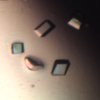Protein Crystal Manipulation Projects
Motivation and Background
Protein crystals are usually incubated in a droplet, about 1-2 ul in volume, that is a mixture of protein and reagent which is necessary to cause nucleation. In the hanging drop method, the droplet is deposited onto a plastic coverslip which is then flipped over to seal the well in the plate where it is going to be incubated. There are many different types of crystallization plates with the number of wells varying depending on their intended use. One very popular type is the 24-well Linbro plate.
The aim of the Protein Structure Initiative is to acquire the structures of as many protein families as possible. The number of the different protein families is estimated to be around 40,000, of which a total of about 600 (as of 2004) are solved per year and deposited to the Protein Data Bank. This makes the task a gigantic undertaking and necessitates the development of strategies and tools for automated and fast manipulation of protein and protein crystals.
There has been a tremendous progress in high-throughput technology development for structural genomics projects in the past decade. Most of highest-demand tasks have been automated to one degree or another. However, there are quite a few tasks that are still performed manually and take valuable time and efforts from crystallographers and lab technicians.
We have identified and are addressing two such tasks: crystal mounting and streak seeding. Our work is aimed at using computer vision to provide the compliance and robustness with precise crystal manipulation requires without the need for extensive analysis of the physics of grasping or a detailed knowledge of the environment.



